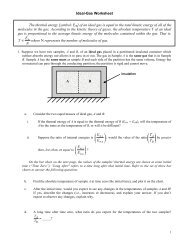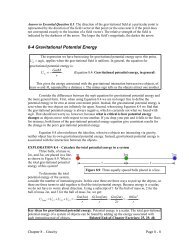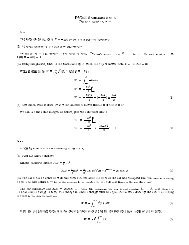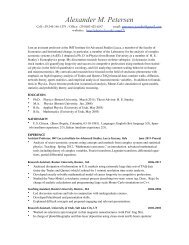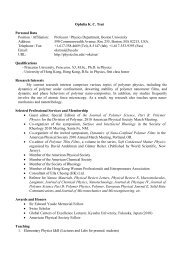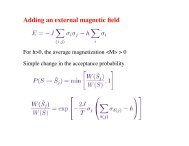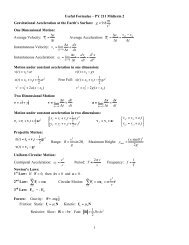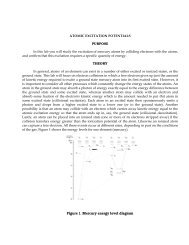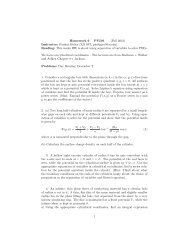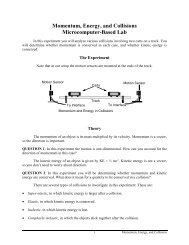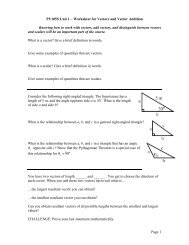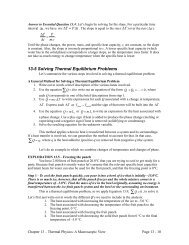Topic 33: Green's Functions I – Solution to Poisson's Equation with ...
Topic 33: Green's Functions I – Solution to Poisson's Equation with ...
Topic 33: Green's Functions I – Solution to Poisson's Equation with ...
- No tags were found...
You also want an ePaper? Increase the reach of your titles
YUMPU automatically turns print PDFs into web optimized ePapers that Google loves.
<strong>Topic</strong> <strong>33</strong>: Green’s <strong>Functions</strong> I – <strong>Solution</strong> <strong>to</strong> Poisson’s <strong>Equation</strong><strong>with</strong> Specified Boundary ConditionsThis is the first of five <strong>to</strong>pics that deal <strong>with</strong> the solution of electromagnetism problemsthrough the use of Green’s functions. We will begin <strong>with</strong> the presentation of a procedurethat permits the solution of electrostatic problems <strong>with</strong> specified charge distributions<strong>with</strong>in a volume V surrounded by a surface S that has specified boundary conditions foreither the potential or the normal component of electric field. To set the stage, considerthe application of Green’s theorem for such a geometry:V22 r r rd ad . rrr(<strong>33</strong>-1) nnNote that we have chosen a prime <strong>to</strong> denote the variable of integration. We choose the r be the electrostatic potential in V. Thereforetwo functions as follows. Let where rrS , (<strong>33</strong>-2)2 ris the charge density. For the other function we choose:0r1 rr (<strong>33</strong>-3)where r is a fixed point in V. <strong>Equation</strong> (<strong>33</strong>-1) becomes: r 1 r1 1 r d 4 0rr 4 rr nVS14r ad Sn1 ad . (<strong>33</strong>-4)rr As S recedes <strong>to</strong> infinity the surface integrals vanish, and we recover Coulomb’s Law,which is not particularly interesting or useful. <strong>Equation</strong> (<strong>33</strong>-4) does suggest thepossibility of a useful expression for evaluating the potential at points in V if Scorresponds <strong>to</strong> an actual physical boundary. However, as it stands, this will not work.This is due <strong>to</strong> the fact that one would need <strong>to</strong> specify both the potential and its derivativeon the boundary in order <strong>to</strong> evaluate the integrals. But such a case would correspond <strong>to</strong>an over-specification since either type of boundary condition suffices <strong>to</strong> uniquelydetermine the potential inside V.Dirichlet Green’s FunctionElectromagnetism, <strong>Topic</strong> <strong>33</strong>, S.P. Ahlen; 09/26/05; 10:18 PM 1
If we modify our choice for rthe situation improves. Suppose that instead of<strong>Equation</strong> (<strong>33</strong>-3) we use the following function: G where the Green’s Function G is subject <strong>to</strong> the conditions:r D r,r , (<strong>33</strong>-5)2 , (<strong>33</strong>-6)D rr4r , rGandD 0r on S. , rG (<strong>33</strong>-7)Then <strong>Equation</strong> (<strong>33</strong>-4) becomes:14 r r0 VD 1 Ddr,rGr4nSr,r G ad . (<strong>33</strong>-8)<strong>Equation</strong> (<strong>33</strong>-8) can be used <strong>to</strong> solve Dirichlet type problems for which the potential isspecified on the surface.Neumann Green’s FunctionSuppose that instead of equation (<strong>33</strong>-5) we use the following function:where G is subject <strong>to</strong> the conditions: G r N r,r(<strong>33</strong>-9)2 , (<strong>33</strong>-10)N rr4r , rGandNnr,r G 4 on S. (<strong>33</strong>-11)SWe have used the symbol S in equation (<strong>33</strong>-11) <strong>to</strong> denote the surface area of the surfaceS. Then <strong>Equation</strong> (<strong>33</strong>-8) becomes:14 r G 0 VN 1 dr,rGr N4nSr1ad SS adr . (<strong>33</strong>-12) Electromagnetism, <strong>Topic</strong> <strong>33</strong>, S.P. Ahlen; 09/26/05; 10:18 PM 2
In this equation, is the angle between the vec<strong>to</strong>rs r and r . The Green’s function forthe exterior problem is easily seen <strong>to</strong> be exactly the same (except that r and r areoutside the sphere in this case).************************************************************************Exercise <strong>33</strong>-1Consider an isolated metal sphere of radius a whose center is located at the origin. Thesphere has no charge on it. A positive charge Q is located at z = R, and a charge –Q islocated at z = R. Let’s find the potential outside the sphere.<strong>Solution</strong> <strong>33</strong>-1The potential on the sphere is zero, which can be seen by calculating the work done inmoving a charge from infinity <strong>to</strong> the surface of the sphere along a line in the xy plane.<strong>Equation</strong> (<strong>33</strong>-8) becomes:14 r 0 VD dr,rGr , (<strong>33</strong>-15)where V is the volume exterior <strong>to</strong> the sphere. This equation yields the potential at allpoints outside the sphere. By using the specified charge distribution, we get: 1 r 40 VˆRrQˆRrQk dr,rGk . (<strong>33</strong>-16)DSo we have: Q ˆR,rGk rDD kˆ R,rG . (<strong>33</strong>-17)40Using equation (<strong>33</strong>-14):D1 R,rG kˆ 2r2 r1R cos2R R2a2ra4a1R cos rR, (<strong>33</strong>-18)22rRwhere is the usual polar angle. With equation (<strong>33</strong>-18) is easy <strong>to</strong> see that:D1 kˆR,rG 2r2 r1R cos 2R R2a2ra4a1R cos rR. (<strong>33</strong>-19)22rRThe answer is thus specified in terms of equations (<strong>33</strong>-17), (<strong>33</strong>-18), and (<strong>33</strong>-19).Electromagnetism, <strong>Topic</strong> <strong>33</strong>, S.P. Ahlen; 09/26/05; 10:18 PM 4
An interesting check of the results can be obtained by letting R approach infinity. In thiscase:andCombining terms we have:DD 1 r2a aR,rG kˆ 1 cos 1cosR R rR rR 1 r2a akˆR,rG 1 cos 1cosR R rR rR 0 r E0r cos 2.3E a cos, (<strong>33</strong>-20)rQ2where E0 is the uniform field produced by the external charges. This is the20R4familiar expression for the electric field outside of an uncharged conduction sphere in auniform field.The charge density on the sphere is easily found <strong>to</strong> be: 3E00cos. (<strong>33</strong>-21)Electromagnetism, <strong>Topic</strong> <strong>33</strong>, S.P. Ahlen; 09/26/05; 10:18 PM 5


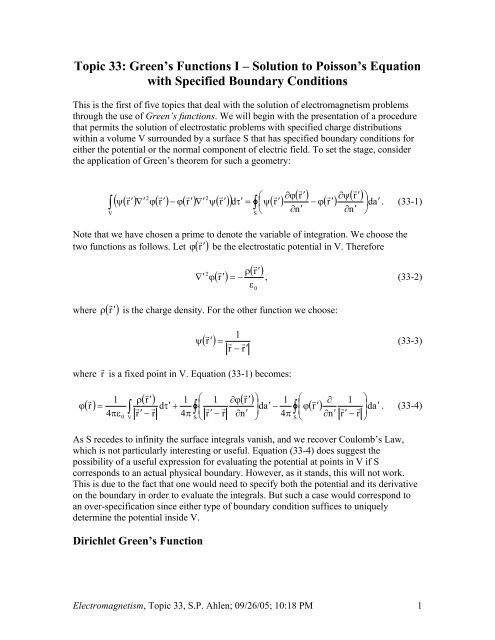
![arXiv:1303.7274v2 [physics.soc-ph] 27 Aug 2013 - Boston University ...](https://img.yumpu.com/51679664/1/190x245/arxiv13037274v2-physicssoc-ph-27-aug-2013-boston-university-.jpg?quality=85)
